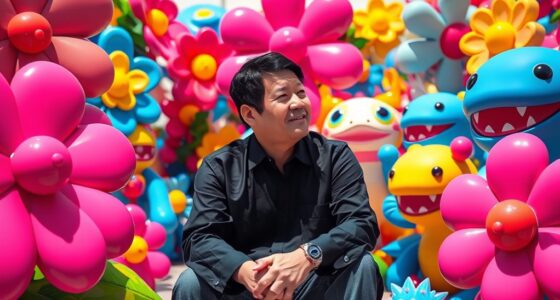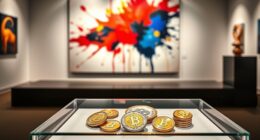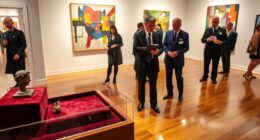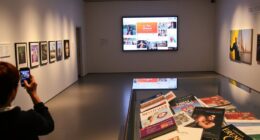Marina Abramović redefines performance art by creating vulnerable, immersive experiences that foster genuine human connection. Her works often involve intense eye contact, physical risk, and audience participation, breaking traditional boundaries. Through her performances, she emphasizes presence, trust, and emotional openness, transforming viewers into active collaborators. Her influence extends beyond art circles, reshaping how we perceive the artist-audience relationship. To explore how she uses vulnerability to forge powerful, transformative moments, keep going.
Key Takeaways
- Marina Abramović uses vulnerability and trust to create authentic human connections through her performance art.
- Her works emphasize presence, endurance, and shared energy, transforming fleeting moments into meaningful experiences.
- Abramović extensively involves audiences, breaking traditional boundaries to foster active participation and emotional exchange.
- She pioneered durational performances like “The Artist is Present,” highlighting the power of silent, sustained engagement.
- Through her institute and collaborations, she redefines performance art’s role in cultural dialogue and emotional impact.
Early Life and Artistic Beginnings

Marina Abramović was born on November 30, 1946, in Belgrade, Yugoslavia, into a family deeply involved in politics and culture. Her parents, Vojin and Danica Abramović, were Yugoslav partisans during WWII and later held high-ranking positions in Tito’s government. Growing up in an affluent, politically active household, she was exposed early to art and culture. She lived with her grandmother, Milica Rosić, until age six, where she absorbed Orthodox spiritual practices that influenced her later work. Her childhood was strict, emotionally distant, and emphasized discipline, shaping her resilience. From a young age, she engaged in creative activities, including drawing and painting, even having her own studio by age twelve. These early experiences laid the foundation for her later experimental and performance art. According to recent studies, her dedication to pushing artistic boundaries has made her a pioneering figure in performance art worldwide.
Core Themes and Philosophies in Her Work

You can see how Abramović’s work embodies vulnerability and trust, pushing both herself and the audience to confront raw emotion. Her performances often explore the fleeting nature of time, emphasizing presence over permanence. By engaging deeply with these themes, she encourages you to reflect on your own limits and the essence of human connection. Her focus on embodied experience and spiritual endurance in her performances further amplifies the profound emotional and physical impact on viewers. Establishing a clear financial timeline can also mirror her emphasis on the importance of timing and process in her art. Additionally, her influence on global accolades underscores the broad recognition and impact of her innovative approach. Recognizing her work’s significance in the context of Vetted – HARTSBURG NEWS highlights her role in shaping contemporary performance art. Her use of unique and wicked planters as a metaphor for nurturing resilience can also be seen as an extension of her exploration of human endurance and growth. Moreover, Abramović’s integration of celebrity relationships and personal vulnerability into her performances demonstrates her ability to blur the lines between personal life and artistic expression.
Embodying Vulnerability and Trust
Embodying vulnerability and trust lies at the core of Abramović’s performance art, where removing barriers fosters genuine human connection. You experience raw honesty as props and distractions disappear, revealing authentic interactions. Both artist and audience expose their emotions and bodies, often through prolonged eye contact that forces confrontation with self and others, generating empathy and discomfort. Performers might be nude or minimally clothed, heightening vulnerability, while audience participation—touching or passing through—breaks traditional boundaries. Abramović’s work demands trust: she surrenders control, risking unpredictability, while viewers must navigate their own limits with silent cues. This vulnerability creates an authentic space where shared risks deepen emotional bonds, illustrating that true art involves personal sacrifice and openness, ultimately fostering transformative connections between artist and audience. This mutual exposure emphasizes that authentic connection arises through shared vulnerability and cultural context, illustrating the powerful role of performance art in human expression. Additionally, understanding the concept of trust in her work highlights how relational dynamics are central to creating meaningful experiences.
Exploring Temporal Presence
What makes Abramović’s performance art so compelling is its deliberate focus on time as an embodied experience. You witness her endurance challenges that stretch hours, days, or weeks, pushing physical and mental limits. Her emphasis on energy exchange highlights the living moment shared between performer and audience, especially in works like “The Artist is Present,” where silent presence creates a profound connection. She transforms fleeting experiences into tangible exhibits, challenging how we perceive art’s temporality. Her performances emphasize real emotions over theatrical illusion, embodying time through sustained presence. By engaging audiences directly, Abramović fosters a shared, collective experience that transcends individual perception. Her innovative use of time blurs boundaries between artist and audience, redefining performance art’s relationship to the passage of time. Additionally, her work often involves regional awareness, as she considers the cultural and social context of her performances to deepen their impact. Recognizing the cultural significance of her actions allows viewers to appreciate how her performances resonate within specific social and historical landscapes. This integration of audience participation further amplifies the emotional and temporal depth of her art, creating an immersive experience that extends beyond the immediate moment. Moreover, her work exemplifies how performance art can serve as a form of cultural dialogue, inviting reflection on societal values and collective memory. Understanding the temporal presence in her performances reveals how she manipulates and explores the perception of time itself within her art.
Notable Performances and Artistic Milestones

Marina Abramović’s career is marked by groundbreaking performances that push the boundaries of physical and mental endurance. You might recall her Rhythm Series (1973–1974), where she tested her limits through intense physical exploration. In Rest Energy (1980), she maintained tense balance with Ulay, holding a bow and arrow aimed at her partner, embodying vulnerability. AAA-AAA (1977), performed with Ulay, confronts audience boundaries through aggressive action, while Breathing In/Breathing Out (1977) pushes participants to near collapse by sharing breath. Imponderabilia (1977) invites visitors to navigate a narrow doorway between two naked performers. Her collaborations, like The Great Wall Walk (1988), symbolize separation and reunion, marking pivotal milestones. Solo works such as Lips of Thomas (1975) and Balkan Baroque (1997) deepen her exploration of trauma, endurance, and cultural memory. Additionally, her performances often utilize virtual environments, expanding audience engagement beyond traditional gallery spaces and harnessing AI technology to create immersive and interactive experiences. This integration of digital tools exemplifies how contemporary performance art increasingly incorporates innovative technologies to deepen audience immersion. This evolution reflects the broader trends in performance art and its adaptation to the digital age, highlighting the importance of technological innovations in artistic expression.
Redefining the Relationship Between Artist and Audience

You become a essential part of the performance when you’re invited to co-create with the artist, blurring the line between observer and participant. Abramović’s work often asks you to embrace vulnerability, showing that emotional exposure can be a powerful form of art. By engaging live and honestly, you reshape the traditional artist-audience relationship into a shared, dynamic experience. Incorporating interactive elements into her performances emphasizes the importance of audience involvement in creating meaningful art. Recognizing the financial impact of performance art, Abramović’s innovative approach underscores how audience participation can elevate art into a collective, culturally significant experience. Additionally, her work highlights the importance of self-awareness and emotional openness in fostering genuine connections. Integrating sound design techniques can further deepen the immersive quality of her performances, creating a richer sensory experience for participants. This approach demonstrates how market volatility can influence the perception and value of performance art, emphasizing its dynamic and evolving nature.
Audience as Co-Creator
In Abramović’s performances, the audience isn’t just a passive observer but an essential participant who co-creates the artwork’s meaning and impact. You become part of the process, influencing how the piece unfolds through your physical and emotional responses. Early works, like her pioneering integration of viewers, shifted the traditional role of spectators from mere viewers to active contributors. In “The Artist is Present,” silent eye contact creates a profound, wordless connection, emphasizing empathy and shared vulnerability. Performance pieces like “Rhythm 0” push boundaries, making you reflect on trust and morality as you engage with her passively or aggressively. Abramović’s work transforms spectatorship into a collaborative experience, where your participation shapes the art’s narrative and emotional resonance, blurring the lines between artist and audience.
Vulnerability as Art
Vulnerability transforms the relationship between artist and audience in Abramović’s performances, turning spectators into active participants in a shared emotional space. When you witness her exposing herself—through physical nudity or prolonged eye contact—you become part of an unpredictable, emotionally charged exchange. Her vulnerability acts as a catalyst, prompting you to confront your own fears and defenses. Abramović’s work reflects your emotional and psychological state, breaking down traditional boundaries of observation. The shared physical and emotional exposure creates a sense of trust, risk, and mutual risk-taking. This vulnerability isn’t just about personal openness; it’s a deliberate artistic act that fosters authentic connection and self-reflection, revealing hidden truths. In her performances, vulnerability becomes a powerful tool for genuine human interaction.
Live Presence Engagement
Marina Abramović revolutionized the way audiences engage with performance art by emphasizing live presence as a central element. During *The Artist is Present*, she performed daily silent sessions for three months at MoMA, highlighting the importance of real-time engagement. Each session required full attendance, turning a simple act into a ritual that transformed passive viewers into active participants. Eye contact and silence became the main communication tools, fostering a shared energy exchange that created a profound emotional connection. Visitors sat face-to-face with Abramović, making each interaction unique and personal. This approach democratized the art experience, breaking down barriers and encouraging vulnerability. The intense, authentic presence of both artist and audience made each moment memorable and deeply impactful.
Establishment of the Marina Abramović Institute

The Marina Abramović Institute, located in Hudson, New York, was thoughtfully designed by the renowned architecture firm OMA led by Rem Koolhaas to serve as a dynamic space for performance art. This building, once a theater and indoor tennis court, now combines museum, theater, laboratory, and boot camp elements. Its purpose is to support ephemeral, durational performances that can last from hours to a year, emphasizing the fleeting power of live art. The design encourages experimentation and collaboration across arts, science, and humanities.
You’ll feel a sense of innovation and reverence for performance art through these features:
- A space that champions both creativity and experimentation
- A platform that preserves and showcases transient works
- A hub fostering interdisciplinary artistic collaboration
Cultural Impact and Mainstream Recognition
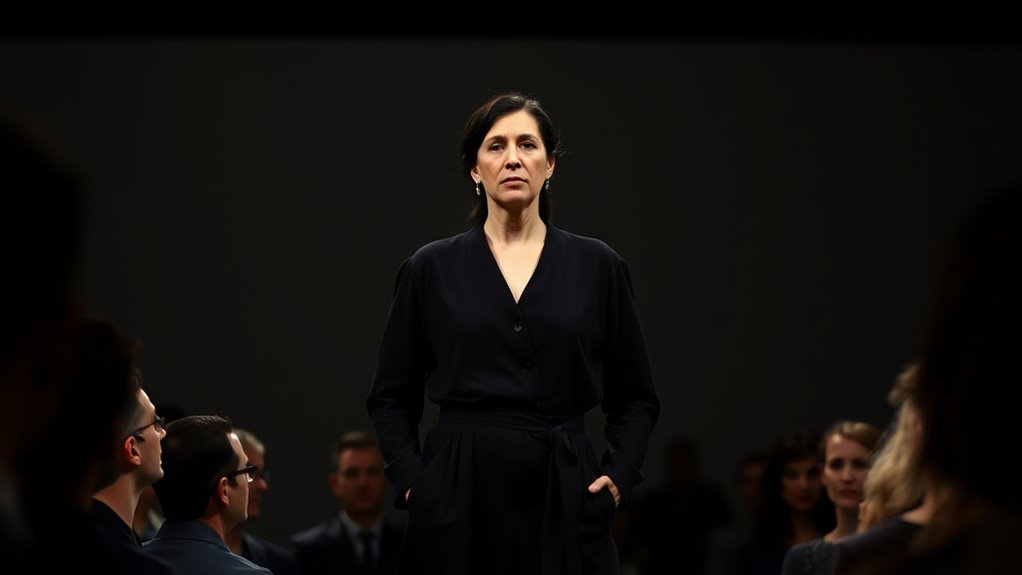
How has performance art transcended its experimental roots to gain mainstream recognition? Abramović’s iconic piece, “The Artist is Present” (2010), drew over 1,000 visitors, creating emotional connections and inspiring blogs like “Marina Abramović made me cry.” Her work increased accessibility, reaching audiences who rarely visit museums. By involving physical endurance and societal challenge, she pushed the boundaries of performance art, expanding its influence. Collaborations with celebrities and pop icons like Lady Gaga introduced her work to younger generations, while her impact inspired novels such as Heather Rose’s “The Museum of Modern Love.” The inclusion of her performances in museums and exhibitions affirms her place in the art historical canon. Abramović’s emotionally resonant and participatory approach transformed performance art into a widely recognized, influential cultural phenomenon.
Continuing Legacy and Influence on Contemporary Art

Emerging artists today draw heavily from Abramović’s innovative practices, embracing her emphasis on art as a meditative and transformative process. Her influence pushes performance art beyond traditional boundaries, inspiring creators to challenge conventions and explore endurance, vulnerability, and relational dynamics. Her fearless experimentation with new mediums keeps her work relevant, setting a precedent for longevity and continuous innovation. You can see her impact in the way contemporary artists use their bodies as a primary medium, fostering deeper emotional connections. Her focus on audience participation has reshaped how art is experienced.
- Feel the emotional power of endurance and vulnerability in new works.
- Witness the blending of performance, photography, and memory as a form of lasting impact.
- Experience art as a shared, transformative journey engaging both artists and audiences.
Frequently Asked Questions
What Inspired Marina Abramović to Focus on Endurance and Body Art?
You’re curious about what drives the focus on endurance and body art. You might find that her upbringing in post-war Yugoslavia exposed her to hardship, inspiring her to test physical and mental limits. You’re also drawn to her desire to explore consciousness, vulnerability, and trust through prolonged performances. Her experiments with the body as a medium challenge societal norms, pushing you to contemplate deeper existential questions and emotional connections.
How Does Abramović Prepare Mentally and Physically for Her Performances?
To prepare yourself mentally and physically for a performance, you focus on mindfulness exercises like slow walking and eye contact to sharpen concentration. You push your endurance with long-lasting activities, practice silence or fasting for mental clarity, and immerse yourself in nature to stay grounded. Daily discipline, self-reflection, and role reversal help you build willpower and adaptability, ensuring you’re fully prepared to confront your limits during the performance.
What Challenges Has She Faced in Gaining Mainstream Acceptance?
You might notice that gaining mainstream acceptance involves overcoming skepticism and misunderstanding. Artists often face rejection from galleries, negative media coverage, and public discomfort with unconventional methods. They struggle to have their work recognized as legitimate art, battling institutional biases and the challenge of preserving ephemeral performances. Despite these hurdles, persistence and innovation gradually help shift perceptions, making it possible to establish performance art as a respected discipline in the broader art world.
How Does Audience Participation Influence the Meaning of Her Work?
Did you know that audience participation is essential in transforming static art into powerful experiences? When you engage actively, you help shape the meaning of the work, making it a shared journey. Your interactions can evoke strong emotional responses, challenge boundaries, and even reveal hidden aspects of yourself. By participating, you don’t just observe—you become part of the art, deepening its impact and creating a unique, personal connection with the performer.
What Are the Future Directions for Her Performance Art Practice?
You see that future directions involve blending traditional performance with new digital media, like NFTs and virtual realities. You might explore interactive, gamified experiences that deepen audience engagement and make art more accessible across generations. Embracing innovative technologies allows you to push boundaries, fostering immersive practices that challenge perceptions of presence and identity. This approach keeps your work evolving, connecting timeless themes with cutting-edge tools to inspire and involve new audiences worldwide.
Conclusion
You witness Marina Abramović’s legacy unfold like a timeless tapestry, where her daring performances transcend eras—imagine her in a Renaissance salon, challenging norms with modern grit. Her fearless exploration of vulnerability and endurance continues to inspire, reminding you that art isn’t just a spectacle, but a profound dialogue. As you reflect, you realize her influence is as enduring as the ancient stones of Stonehenge, forever shaping the landscape of contemporary performance art.



